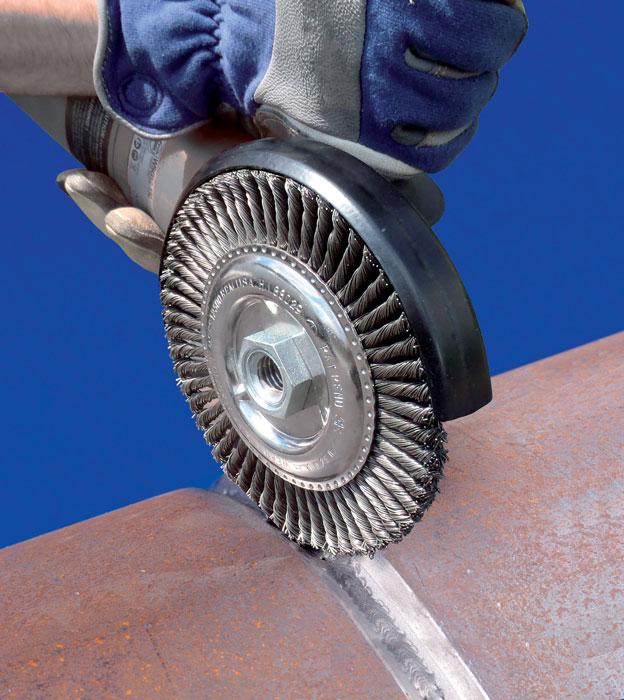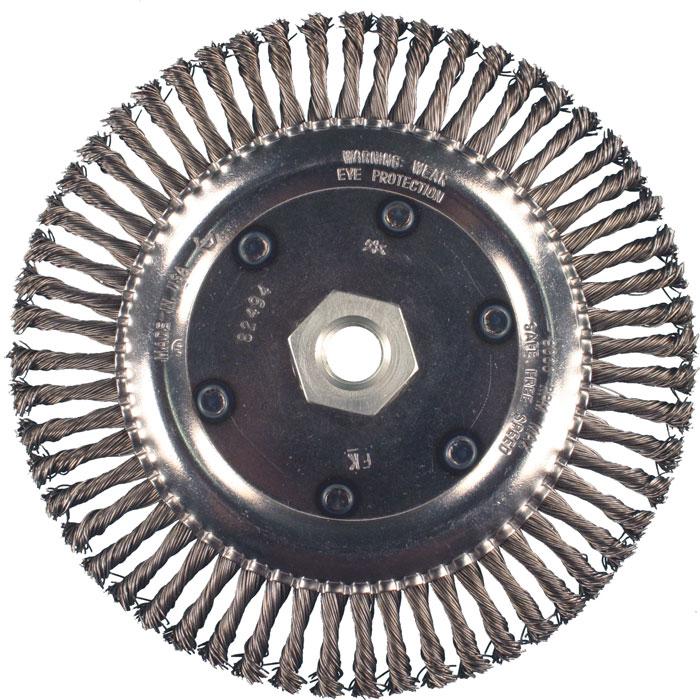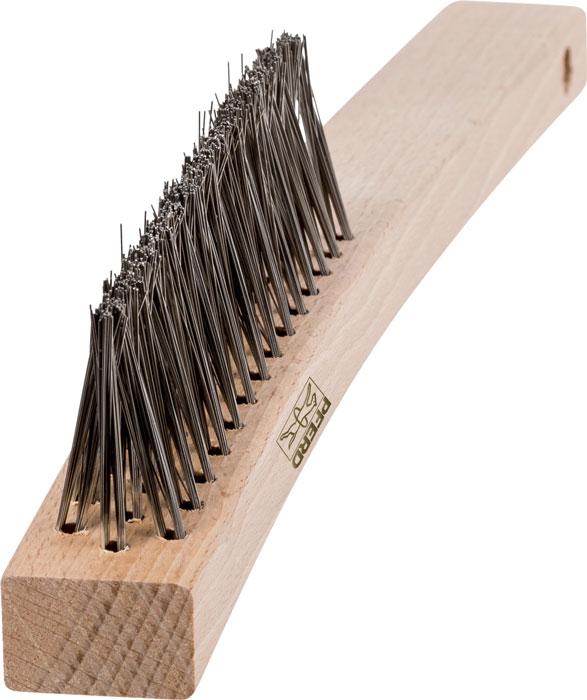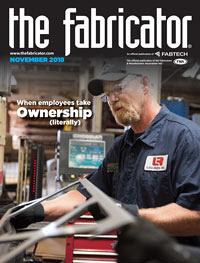Technical Product Specialist
- FMA
- The Fabricator
- FABTECH
- Canadian Metalworking
Categories
- Additive Manufacturing
- Aluminum Welding
- Arc Welding
- Assembly and Joining
- Automation and Robotics
- Bending and Forming
- Consumables
- Cutting and Weld Prep
- Electric Vehicles
- En Español
- Finishing
- Hydroforming
- Laser Cutting
- Laser Welding
- Machining
- Manufacturing Software
- Materials Handling
- Metals/Materials
- Oxyfuel Cutting
- Plasma Cutting
- Power Tools
- Punching and Other Holemaking
- Roll Forming
- Safety
- Sawing
- Shearing
- Shop Management
- Testing and Measuring
- Tube and Pipe Fabrication
- Tube and Pipe Production
- Waterjet Cutting
Industry Directory
Webcasts
Podcasts
FAB 40
Advertise
Subscribe
Account Login
Search
3 ways to reduce the fatigue factor in finishing
Ergonomics affect a worker’s ability to finish well
- By Jordan Schimel
- October 30, 2018
- Article
- Finishing

A power wire brush works with the wire tips only. If the brush is pushed too hard, the sides of the wire engage instead of the tip, which just builds up heat.
Pipeline fabricators who perform finishing in the field often find themselves in demanding and strenuous environments. They may have to work with limited mobility under a pipe; battle the elements in the cold, under a blistering sun, or in the mud; and operate a 15-pound, 9-inch right-angle grinder that’s throwing 1,600-degree sparks in every direction above their heads.
While these may be extreme examples, they do exist, and call to attention the need for ergonomic finishing equipment for work done frequently, even daily. Physical factors such as vibration, bright sparks, and loud noise can directly impede the fabricator’s ability to work for extended periods of time before operator fatigue results. These conditions affect a worker’s ability to perform consistently, such as applying the proper contact pressure when grinding, and increase the need for more frequent breaks throughout the day. They may even cause long-term effects such as hearing loss or repetitive-use injuries.
Following are three suggestions to reduce the human fatigue factor:
1 Use Proper Grit, Bond Hardness, Abrasive
Typically, the focus is on getting the grinding job done quickly. There’s often a tendency to equate coarse grits, such as 24-grit, with faster grinding. While logical in theory, in practice it presents certain challenges.
With a coarse grit in bonded abrasives, more vibration is generated, which can actually decrease the amount of contact between the abrasive and the workpiece. As a result, more time is needed to get the job done. A slightly finer grit, such as a 36-grit grinding wheel, can ensure maximum, consistent contact. This will reduce vibration, increase contact time, and greatly increase control. Greater control improves the finisher’s precision within tight geometric specifications and constraints, while the reduced vibration decreases fatigue and improves consistency and productivity.
Another aspect to consider with resin-bonded products is the bond hardness. Using the appropriate bond hardness for the specific application will ensure maximum product life and optimal performance. When a fabricator uses a low-powered grinder with a wheel that’s too hard, the wheel won’t wear away quickly enough to expose new abrasive grains and will glaze over, becoming all but useless. If the bond is too soft, it will wear extremely fast. The material being worked on should determine the bond selection. Adjustments can be made as needed, moving to a slightly harder wheel to increase lifespan, or to one slightly softer if the desire is more aggressive metal removal. One strategy will reduce changeover time, while the other increases how much product is consumed. It is up to the individual operator to determine the “sweet spot.”
Coated abrasives offer benefits. Because of its engineered grain orientation, a coated abrasive removes stock faster. This improves the ergonomics by reducing the pressure required to wear down and remove stock. Additionally, this material vibrates substantially less and creates far less noise. While the cost per piece of a coated abrasive can be slightly higher than that of a bonded wheel, the time savings realized via increased stock removal reduces operating costs overall. The savings achieved in time and increased productivity outweigh the small increase in per-consumable piece price.
2 Practice Speed Control
“Faster is better” in terms of overall job completion. However, it’s important to know when faster is better--and more importantly, when it isn’t.
A general assumption is that higher speeds can be achieved by using the largest-diameter abrasive/brush appropriate for the power tool. At first glance, this makes mathematical sense, because the surface feet per minute (SFPM) of the largest-diameter wheel will result in the highest rate of contact with the workpiece. However, in some scenarios, faster is not better. High rotations per minute (RPMs) with high mass-bonded products can cause problems. For example, the heavier loads can wear the power tool faster and hamper operator control. Also, higher running speeds generate more heat and premature consumable destruction, especially in surface conditioning and finishing operations.
In particular, working with wire brushes that are operating too fast can cause even greater problems. Wire brushes have an optimal SFPM where they perform best. The proper RPMs can be determined using the formula below:

Figure 1
A wire brush that is designed so that it can be mounted facing either direction and guarded no matter which side is facing which way provides expediency.
This means for a 6-in. wire wheel brush to run at its optimal peripheral speed of 5,000 to 9,500 SFPM for weld cleaning and scale removal, it should run at an RPM of between 3,400 and 6,000.
What is great about math is that it does not lie. It’s evident exactly where the optimal speeds are and what “too fast” means. In the example above, it’s clear that on a standard 6-in. angle grinder at 9,000 RPM, the wheel would run much too fast to do its best work. When a wire brush runs too fast, it does not engage with the workpiece properly. This results in a lack of control and improper surface conditioning.
A common reaction to the surface not being abraded well is to push harder. This is not the solution. To understand why applying more pressure will not help, it’s important to understand how a power wire brush works.
The work is done with the wire tips only. If the brush is pushed too hard, the sides of the wire engage instead of the tip (see Figure 1). This does nothing other than build up heat, which could cause discoloration of the workpiece, fatigue, and premature wire failure. Additional time is required to resolve these problems.
In pipeline operations, each completed weld needs to be cleaned free of slag and scale before the next pass can be performed. It is uncommon for a pipe to be prepped and ready for welding. Most pipes have a coating of some sort to prevent corrosion, so conditioning is required on the outer diameter and inner diameter of the material.
A wire brush is ideal to perform this application. It generates minimal heat buildup. Also, unlike abrasives, its non-geometry-altering surface conditioning ability and nonloading properties work well for coatings, paints, and oils. When it is run in the optimal speed ranges, it allows for the fastest surface conditioning and the longest product life with the least amount of fatigue while providing maximum life for the power tool.
3 Use Best Tools on the Job Site
Metalworking is more complex than most realize. Different materials and alloys present different challenges. Abrasive grains act differently on different materials. The human factor is dynamic. With so many variables to consider, what are some helpful ways to improve efficiency? How can a fabricator use the proper product at the right speed?
Understanding the application and selecting the right product are paramount. This guarantees optimal efficiency in the overall process.
Fabricators can achieve best results with products intended to improve process turnaround times and that work optimally in specific areas. For example, a wire brush that is designed so that it can be mounted facing either direction and guarded no matter which side is facing which way provides expediency (see Figure 2). In addition, it lasts longer because the brush’s surface can be reversed occasionally. Also, this improves its performance because the angle at which the filament tips have been worn creates less heat and conditions the surface faster.

Figure 2
Extreme working conditions call to attention the need for ergonomic finishing equipment for work done frequently.
Revisiting the topic of ergonomics, it’s clear that simple product features can contribute significantly to operator comfort and efficiency. When a finisher is working under a pipe in the mud or in wet conditions, a conventional handle may result in slippage. An ergonomic handle that is designed to provide a firm grip in wet conditions also gives the operator control and reduces the chance of injury caused by exposed file tangs.
Working with a designated pipeline grinding wheel means it will wear properly on the periphery to reduce porosity and inclusion on the surface.
Last, a well-powered, variable-speed tool may be one of the best investments a finisher can make, particularly if a lot of work revolves around brushing or finishing applications. Working within the proper SFPM speeds will reduce the number of consumables needed and will get the job completed in a more effective and timely manner.
When getting the job done quickly, efficiently, and properly is the goal, understanding the physical properties and impact of the products to use is the most important part of the equation.
Jordan Schimel is technical product specialist for Pferd Inc., sales@pferdusa.com; 262-255-3200, www.pferd.com
About the Author
Related Companies
subscribe now

The Fabricator is North America's leading magazine for the metal forming and fabricating industry. The magazine delivers the news, technical articles, and case histories that enable fabricators to do their jobs more efficiently. The Fabricator has served the industry since 1970.
start your free subscription- Stay connected from anywhere

Easily access valuable industry resources now with full access to the digital edition of The Fabricator.

Easily access valuable industry resources now with full access to the digital edition of The Welder.

Easily access valuable industry resources now with full access to the digital edition of The Tube and Pipe Journal.
- Podcasting
- Podcast:
- The Fabricator Podcast
- Published:
- 04/16/2024
- Running Time:
- 63:29
In this episode of The Fabricator Podcast, Caleb Chamberlain, co-founder and CEO of OSH Cut, discusses his company’s...
- Industry Events
16th Annual Safety Conference
- April 30 - May 1, 2024
- Elgin,
Pipe and Tube Conference
- May 21 - 22, 2024
- Omaha, NE
World-Class Roll Forming Workshop
- June 5 - 6, 2024
- Louisville, KY
Advanced Laser Application Workshop
- June 25 - 27, 2024
- Novi, MI































